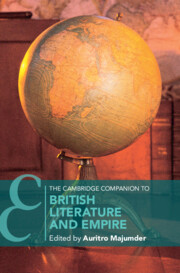Refine search
Actions for selected content:
22661 results in Cambridge Companions
1 - Early Modern Utopia
- from Part I - Early Intimations and Literary Genres: 1500–1800
-
-
- Book:
- The Cambridge Companion to British Literature and Empire
- Published online:
- 20 November 2025
- Print publication:
- 04 December 2025, pp 19-35
-
- Chapter
- Export citation
Index
-
- Book:
- The Cambridge Companion to British Literature and Empire
- Published online:
- 20 November 2025
- Print publication:
- 04 December 2025, pp 326-331
-
- Chapter
- Export citation
Part II - Entanglements of Prose, Poetry, and Empire: 1800–1900
-
- Book:
- The Cambridge Companion to British Literature and Empire
- Published online:
- 20 November 2025
- Print publication:
- 04 December 2025, pp 107-186
-
- Chapter
- Export citation

The Cambridge Companion to British Literature and Empire
-
- Published online:
- 20 November 2025
- Print publication:
- 04 December 2025
Contributors
-
- Book:
- The Cambridge Companion to the Nazi-Soviet War
- Published online:
- 13 November 2025
- Print publication:
- 20 November 2025, pp xii-xvi
-
- Chapter
- Export citation
Part IV - Criminality and Occupation
-
- Book:
- The Cambridge Companion to the Nazi-Soviet War
- Published online:
- 13 November 2025
- Print publication:
- 20 November 2025, pp 227-262
-
- Chapter
- Export citation
Part II - Kingship in Practice
-
- Book:
- The Cambridge Companion to Late Medieval English Kingship
- Published online:
- 03 November 2025
- Print publication:
- 20 November 2025, pp 65-192
-
- Chapter
- Export citation
3 - Stalin’s Political Delusions and Military Preparations for War with Nazi Germany
- from Part I - Conceptions of War
-
-
- Book:
- The Cambridge Companion to the Nazi-Soviet War
- Published online:
- 13 November 2025
- Print publication:
- 20 November 2025, pp 45-64
-
- Chapter
- Export citation
11 - Operation Bagration, 1944
- from Part III - Campaigns
-
-
- Book:
- The Cambridge Companion to the Nazi-Soviet War
- Published online:
- 13 November 2025
- Print publication:
- 20 November 2025, pp 190-206
-
- Chapter
- Export citation
A Guide to Further Reading
-
- Book:
- The Cambridge Companion to the Nazi-Soviet War
- Published online:
- 13 November 2025
- Print publication:
- 20 November 2025, pp 382-388
-
- Chapter
- Export citation
1 - Events, Personalities and Reputations
- from Part I - Chronology and Context
-
-
- Book:
- The Cambridge Companion to Late Medieval English Kingship
- Published online:
- 03 November 2025
- Print publication:
- 20 November 2025, pp 3-23
-
- Chapter
- Export citation
16 - The Soviet War Effort
- from Part V - Home Fronts
-
-
- Book:
- The Cambridge Companion to the Nazi-Soviet War
- Published online:
- 13 November 2025
- Print publication:
- 20 November 2025, pp 281-298
-
- Chapter
- Export citation
Part II - Opposing Forces
-
- Book:
- The Cambridge Companion to the Nazi-Soviet War
- Published online:
- 13 November 2025
- Print publication:
- 20 November 2025, pp 65-116
-
- Chapter
- Export citation
3 - Events, Personalities and Reputations
- from Part I - Chronology and Context
-
-
- Book:
- The Cambridge Companion to Late Medieval English Kingship
- Published online:
- 03 November 2025
- Print publication:
- 20 November 2025, pp 44-64
-
- Chapter
- Export citation
Part VI - Comrades in Arms
-
- Book:
- The Cambridge Companion to the Nazi-Soviet War
- Published online:
- 13 November 2025
- Print publication:
- 20 November 2025, pp 299-346
-
- Chapter
- Export citation
2 - Events, Personalities and Reputations
- from Part I - Chronology and Context
-
-
- Book:
- The Cambridge Companion to Late Medieval English Kingship
- Published online:
- 03 November 2025
- Print publication:
- 20 November 2025, pp 24-43
-
- Chapter
- Export citation
Part I - Chronology and Context
-
- Book:
- The Cambridge Companion to Late Medieval English Kingship
- Published online:
- 03 November 2025
- Print publication:
- 20 November 2025, pp 1-64
-
- Chapter
- Export citation
Figures
-
- Book:
- The Cambridge Companion to the Nazi-Soviet War
- Published online:
- 13 November 2025
- Print publication:
- 20 November 2025, pp viii-x
-
- Chapter
- Export citation
10 - The Siege of Leningrad, 1941–1944
- from Part III - Campaigns
-
-
- Book:
- The Cambridge Companion to the Nazi-Soviet War
- Published online:
- 13 November 2025
- Print publication:
- 20 November 2025, pp 174-189
-
- Chapter
- Export citation
2 - Political Thinking and Strategic Planning for Hitler’s Lebensraum in the East
- from Part I - Conceptions of War
-
-
- Book:
- The Cambridge Companion to the Nazi-Soviet War
- Published online:
- 13 November 2025
- Print publication:
- 20 November 2025, pp 27-44
-
- Chapter
- Export citation
